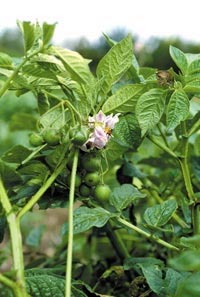

"Most of the plant breeding programs of the twentieth century have totally failed to achieve their objective of increasing resistance to disease and pests. We are actually increasing the susceptibility of many of our crops to disease and parasites." Dr. Raoul Robinson
Until a few hundred years ago saving seed of varieties particularly well-adapted to a farmer's local conditions was an integral part of farming. Restoring Our Seed is advancing the ancient art of seed-saving by introducing selective seed-saving for durable resistance.
If you are an organic potato grower concerned by potato beetles, low yield, late blight, or not enough flavor, and want a superior potato well-adapted to your farm conditions, try creating your own variety! Breeding potatoes is easy, and can be a highlight of your market outreach.
|
Bryan Connolly crossed Blossom (the maternal plant) that produces abundant flowers, has dazzling magenta-red skin and pink flesh, rich, earthy flavor, is resistant to leaf-hoppers and late blight, with: Caribe: Earliest, high-yielding lustrous purple skin
covers smooth snow-white flesh. |
Growing Potato from Seed
Use a small seed drill, or sow by hand. Let blight and beetle do their worst. The most susceptible seedlings will die. Mark the most resistant with a brightly painted stick. These may look susceptible in the early breeding cycles but that's ok. They will be more resistant than all the others. Pull out all the others. Let the bees cross-pollinate all the selected plants. If Colorado beetles are likely to devour the plants before they set fruit, either hand-pick off the egg custers and beetles or protect with Bt or natural pyrethrum. The object is to harvest the potato fruits which are the result of pollination.
When 50-100 potato fruits are soft like a ripe tomato, harvest them. Put the fruits in a kitchen blender, cover with water, and blend just enough to break up the fruits and liberate the seeds. Leave this mixture in a plastic bowl to ferment a day. The seeds sink. With several rinsings, you will have clean seeds. Drain seed and spread on a paper towel to dry. These will be the parents of the second breeding cycle. Come spring, sow again. Repeat for several years, discarding plants with poor flavor or low resistance.
You will be amazed how quickly resistance to beetle and blight accumulate a multi-gene durable resistance. It will not break down to new races of blight fungus in the way single-gene resistances do.

'TPS-true potato seed-is harvested from the berries that grow among the foliage of potato plants. An average plant produces dozens of berries, each of which contains hundreds of tiny seeds. Similar in appearance to tomato seed, TPS is usually sown in seedbeds three or four weeks prior to the potato planting season. The plants in the beds produce small tubers, sometimes called tuberlets, which farmers plant in the field much as they would conventional seed tubers.
This practice sidesteps much of the drudgery involved in handling heavy seed tubes, provides farmers with vigorous disease-free seed, and eliminates the need to store part of the previous year's crop for following year's planting. Many of the production problems that potato farmers experience result from the deterioration of the seed tubers they save for planting, storing them for eight to nine months in inadequate storage facilities.
TPS tuberlets, which are normally no larger than 2.5 centimeters in diameter, rival the best tuber seed produced by commercial seed companies.' International Potato Center Annual 2003 report <cipotato.org>

